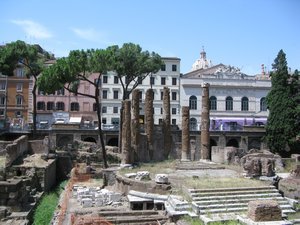Advertisement
Published: August 3rd 2009

 Largo Argentina
Largo Argentina
In 1926, when the owner of a building in downtown Rome tried to build something new, they found there were 4 Roman temples under the ground. (dated around 300 or 400 B.C.) It was part of a bigger Roman "living area". They call it Largo Argentina now and forms the bus and tram hub in Rome. It also became a cat sanctuary, you can see many cats around at night.I have been putting off writing about my experiences for Rome for a few days. Partly because my day was full exploring what was on offer, but also because Rome is a place that put me in a different mood that required a few days of reflection before I could organize these experiences into a coherent account. Rome is a special place because it was the cradle of the Western Civilization; it is a city of ancient origin and also, it is where Vatican- the Holy See- is situated.
The first day, I hired an Italian guide to give me a general tour of the city. We stopped at many buildings that had ancient origins (Roman or Medieval) but which were either razed, adapted, or reused by the later generations. Some of them merged imperceptibly into the modern buildings with some remaining vestiges, some were totally destroyed. That is a constant theme that emerged from the first day visit of Rome.
- The Christians built Churches on top of the pagan temples to "purity" the pagan influences.
- The bronze inside the Pantheon was stripped out and melted to form the pillars inside St. Peter's Basilica
- Mussolini razed
ancient buildings to build the "New Rome", imitating the Roman Emperor Augustin...etc.
Given that Rome is so ancient, it is almost impossible not to destroy in order to build. It is always a delicate balance, what to destroy, and what not to destroy. Often, as in many other things, if we do not surrender gracefully the things of the past, we will never be able to move on. However, I tend to think that the heritage of Rome, the "soft" aspects of the civilization, lived on, grew and never stopped, while the "hard" aspects may appear and disappear with time. Here are some pictures:
I will write about Vatican tomorrow...
Advertisement
Tot: 0.047s; Tpl: 0.02s; cc: 7; qc: 23; dbt: 0.0188s; 1; m:domysql w:travelblog (10.17.0.13); sld: 1;
; mem: 1.1mb

 Largo Argentina
Largo Argentina








